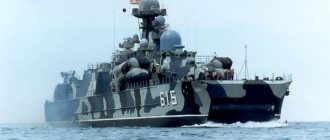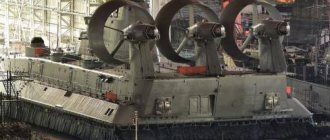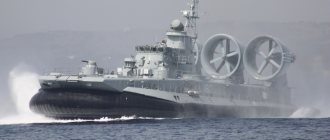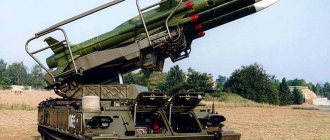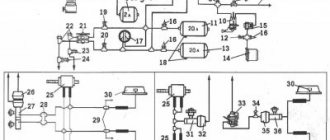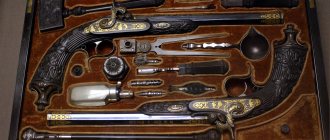Missile hovercraft "Samum" of the Black Sea Fleet. Photo: A. Brichevsky / Information support department of the Black Sea Fleet
The Rybinsk shipyard, together with other shipbuilding enterprises of the Kalashnikov concern, is working on the creation of a multifunctional skeg-type hovercraft, the Haska 10.
The premiere of the new product should take place this year. In terms of its dimensions, the vessel will be able to accommodate a three-axle KAMAZ tractor, and in total it can take on board up to 10 tons of payload. But the main feature of the Husky is the introduction of flexible skeg fencing into the design. It is noteworthy that Russian scientists and engineers have the most experience in the world in creating skeg-type ships. About past domestic developments on this topic and the prospects for the development of skeg-type hovercraft - in our material.
"Bora" and "Samum" - small hovercraft missile boats
There are no analogues in the world to these unique small hovercraft missile boats “Bora” and “Samum” of Project 1239 “Sivuch”. The sailors themselves call them “Sea Destroyer.” When attacking the enemy, suddenly approaching at enormous speed, which is twice the speed of any surface ship, he destroys the flagship of the enemy squadron with missiles brought into combat position in just thirty seconds, leaving it without command. And he leaves there at the same speed, allowing him, after delivering a blow, to instantly leave the zone of destruction of the enemy’s fire forces.
Air-supported
The idea of lifting a ship from the water into the air to reduce drag and increase speed has always been very attractive to shipbuilders. A hundred years before the appearance of the first steamships and two hundred years before the first flights on airplanes, there was already a project that can be called the prototype of modern hovercraft. In 1716, the Swedish scientist Emmanuel Swedenborg proposed using blades and muscle power to pump air under a canvas dome, on which people and cargo could be moved. The idea remained on paper, since no amount of muscle power could lift such a device.
It became possible to make something like this a reality only with the advent of internal combustion engines. In 1915, the Austro-Hungarian officer and inventor Müller von Thomamühl built an experimental supercharged torpedo boat, the Fersuchsgleitbot, which could accelerate to 40 knots (just over 70 km/h). But it was not only on water that they proposed accelerating cars using an air gap. In 1926, Konstantin Tsiolkovsky expressed the idea of a high-speed train without wheels, the movement of which would be based on the use of air pressure.
Supercharged torpedo boat "Ferzuhsgleitbot"
Our country was the first to create operating skeg-type “air ducts”. Work on them began in 1927 under the leadership of Professor V.I. Levkova. Hovercraft (hovercraft) were developed for military use. At the end of the 1930s, Levkov’s boat “L-5” weighing 9 tons reached a speed of 73 knots (more than 135 km/h). It was built according to the skeg type of construction.
Levkov also worked on a chamber-type hovercraft, but this direction was not developed. The inventor of the nozzle method of forming an air cushion, which is used in most hovercraft today, is considered to be the Englishman Christopher Cockerell. According to legend, he discovered the principle of the air barrier by experimenting with two tin cans inserted one inside the other. In 1955, Cockerell patented a hovercraft design called Hovercraft. And in 1959, the first ship he built, SR-N1, crossed the English Channel in 20 minutes.
Hovercraft SR-N1
The “golden age” of hovercraft occurred in the 1960s and 70s, when designers and shipbuilders had high hopes for a new type of vessel. However, practical application has shown that hovercrafts are quite expensive to construct, operate and maintain. This type of transport did not become widespread, as the inventors of the hovercraft dreamed of. And yet there are areas where there is no alternative to hovercraft yet, and their disadvantages are more than compensated by their advantages.
Missile boats "Bora" and "Samum" - video
The ship consists of two narrow hulls covered by a platform (64 x x 18 m). There is an elastic screen in front. Two gas turbines accelerate it to 50 knots at a wave height of 2 m, and at a wave of 3.5 m (wind force 5) - up to 40 knots. On the one hand, it is a catamaran with a speed of up to 25 knots, on the other, a STOL with a maximum speed of up to 50 knots. High speed allows the ship to avoid being captured by torpedo seekers. Seaworthiness - up to 8 points. However, despite its impressive dimensions and displacement, its missile and artillery armament is the same as that of the boat pr. 1234.8 (whose displacement is 400 tons less and whose hull width is 6 m less). True, the large deck area made it possible to create more comfortable conditions for using weapons and accommodating the crew. The complexity of construction and operation, the high cost of both, with insufficiently powerful weapons, predetermined the fate of the project. The series was limited to two units.
TTD:
Displacement: 1050 tons. Dimensions: length - 65.6 m, width - 17.2 m, draft - 3.3 m (>1 m when superchargers are running) Full speed: 55 knots Cruising range: 2500 miles at 12 knots, 800 miles at 45 knots Power plant: 2 gas turbine units M10-1 36,000 hp (for tandem propellers, in lowered columns), two M-511A 20,000 hp diesel engines (for 2 propellers), two M-504 6,600 hp diesel engines. (for blower fans) Armament: 2x4 Moskit anti-ship missile launchers (8 3M80 missiles), 1x2 Osa-M air defense missile launchers (20 missiles), 1 76-mm AK-176 artillery mount, 2x6 30-mm gun mounts AK-630 Crew: 68 people.
Ship history:
Rocket hovercraft pr.1239
The hovercraft missile ship (RKVP) was created as a development of small missile ships of projects 1234 and 1234.1. The experience of using small missile ships in combat service in the Mediterranean Sea has shown that ships of this size and classical formations are limited in the placement of weapons. Catamaran pr.1239 has a large deck, which allows solving this problem, more comfortable conditions for using weapons and accommodating the crew. In addition, it has high seaworthiness. When creating the RKVP, the experience of the Almaz Central Marine Design Bureau and the shipbuilding industry, acquired during the construction of air-cushion landing ships such as Dzheiran, Zubr, etc., was also widely used.
The ship consists of two narrow hulls covered by a platform 64 m long and 18 m wide. There is an elastic screen in front. Two gas turbine engines with a power of 60 thousand hp each. allow you to reach a speed of up to 55 knots even with a wave height of 2 m, and with 5 points (wave 3.5 m) - more than 40 knots. High speed allows the ship to avoid being captured by homing missiles; for the same reason, a torpedo does not have time to catch up with it. For economical running, two diesel engines are installed. Seaworthiness - up to 8 points.
RKVP has unique shipbuilding qualities. First of all, these include the transformability of the hydrodynamic platform and versatility - 36 options for using the propulsion system. On the one hand, the ship is a catamaran with a speed range of up to 20 knots, on the other, it is a high-speed hovercraft with a maximum speed of over 50 knots. In both cases, the CODAG propulsion system, combined propulsion system and convertible flexible cooling system allow the ship to have a wide range of propulsion modes in both normal and emergency conditions.
Having two separate propulsion systems for cruising and full speed, capable of working separately and together, the ship can move in three main modes (catamaran, KVP-1 and KVP-2), which provides an almost 100% guarantee of progress in any situation. Thus, over all the past years of operation of the RKVP, there has not been a case where the ship returned to base in tow. Moreover, the possibility of moving with the propulsors turned off was carried out. The RKVP, when operating only the supercharger engines, was capable of moving due to the outflow of air from the air cushion to the stern against the wind (7 m/sec) at a speed of 3 knots.
The first missile hovercraft, Project 1239, was the Bora RKVP, laid down in 1984 at a plant in Zelenodolsk near Kazan. Soon after the firstborn, the second ship of this series, Samum, was laid down.
The hovercraft missile ship "Samum" (until March 18, 1992 - MRK-17) was laid down on the shipbuilding slipway in Zelenodolsk in September 1991 (serial number 502), launched on October 12, 1992, accepted into trial operation in March 1992. It was transferred along inland waterways to the Black Sea, in November 1992 it arrived in Kerch, and in March 1993 - in Sevastopol. Then the ship was again sent to the construction plant, arriving in Zelenodolsk in October 1993. In September 1994, it went to the Baltic Sea via inland waterways, and from December 1996 it underwent state tests in Baltiysk, and was officially put into operation on 02/26/2000. It was part of the 36th brigade of missile boats of the Baltic Fleet.
In April 2002, this RKVP under the command of Captain 2nd Rank V. Sakov was relocated from the Baltic to the Black Sea Fleet, becoming part of the 166th Novorossiysk Red Banner Division of small missile ships of the 41st Separate Brigade of Missile Boats of the Black Sea Fleet.
The experience of using the ship in fleet combat training gave reason to the Black Sea Fleet command to believe that Project 1239 ships, in terms of their tactical and technical characteristics, are optimal attack ships for ice-free closed sea theaters, significantly enhancing the combat potential of missile boat brigades.
This ship was commanded at different times by: - Captain 2nd Rank Oleg Sardin; - captain 3rd rank Vladimir Derbetov; - Captain 2nd rank Alexander Zhurkin.
Tactical and technical characteristics of the boats "Bora", "Samum"
Displacement…………………1050 t.
Overall dimensions of Bora, Samum
Length……………………65.6 m Width…………………17.2 m Draft……………………3.3 m (>1 m when blowers are running)
Engines Bora, Samum
2 GTU M10-1 36,000 l. With. (on tandem propellers, in lowered columns), two diesel engines M-511A 20,000 l. With. (for 2 screws) Power……………………2 × 36,000 l. With. and 2 × 20,000 l. With. Propulsion……………………2 Speed……………………55 knots (101.9 km/h) Cruising range………………………total: 800 miles (45 knots), economic : 2500 miles (12 knots) Crew…………………68
Armament of Bor, Samum
Artillery……………………1 × 76-mm gun mount AK-176, two 6-barreled 30-mm AU AK-630 Missile weapons………………………2 × 4 launchers for anti-ship missiles "Mosquito" ( 8 3M80 missiles); 1 × 2 Osa-M air defense missile launchers (20 missiles)
"Huska 10": multi-purpose "air duct"
In 2022, designers of the Rybinsk shipyard, part of the Kalashnikov concern, began developing the Haska 10 skeg-type hovercraft. The vessel is designed for multi-purpose use and is being created as part of the state program for the development of shelf fields. With its help, the regions of Siberia, the Far East, the Arctic and the rivers of the Volga-Kama-Baltic region will become more accessible.
“Huska” can carry up to 10 tons of cargo and place on board, for example, a three-axle KAMAZ tractor. Vessel length – 20.8 m, width – 12.5 m, height – 7.4 m, displacement – 35.7 tons, power plant power – 4x800 hp, speed – 40 knots. The vessel is operated by a crew of 3 people. In autonomous mode, the vessel can spend up to 3 days with a cruising range of up to 400 miles.
Scheme "Huska 10". Photo: Rybinsk shipyard
A special feature of the Husky design is flexible skeg fencing. It is the skegs that are considered one of the weak points of this type of hovercraft. If for amphibians damage to the “skirt” is not critical, then the failure of a rigid skeg turns the skeg vessel into an ordinary displacement ship with a loss of speed and all other advantages of the hovercraft. Flexible skegs partly solve this problem; they are more resistant to impacts and can bend around obstacles.
At the moment, work on “Huska 10” is in full swing. The Rybinsk shipyard is engaged in construction together with another enterprise of the Kalashnikov shipbuilding cluster. The premiere of the new hovercraft should take place this year.
Model "Huska 10". Photo: Rybinsk shipyard
Skeg-type hovercraft have good prospects both in the navy and in civilian life. In terms of versatility and speed capabilities, they have no equal in the class of vessels with a displacement of up to 1000 tons. The skeg design is suitable for creating high-speed transport ferries, landing ships, and for search and rescue operations. There are ideas for creating helicopter carriers based on skeg hovercraft. Thanks to developments such as the Haska 10, there remains hope that the rich experience of domestic designers in creating skeg “air ducts” will be in demand in the future.
